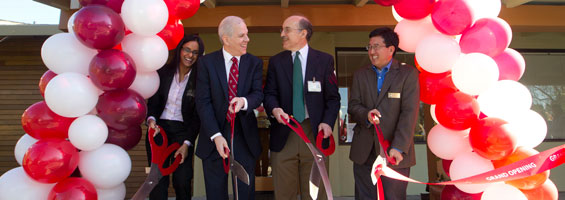Overview
Our Mission
We lead the fields of transfusion and transplantation medicine by advancing science and technology. We provide hope for the future by teaching the medical leaders of tomorrow. We enhance lives by connecting donors to patients every day.
A Brief History
Stanford Blood Center was created within the Department of Pathology at Stanford University School of Medicine in 1978. The Blood Center was created to meet the increasingly large and complex transfusion needs of Stanford Hospital and Lucile Salter Packard Children's Hospital at Stanford, and to perform research and teaching.
Milestones
The history of the Blood Center is replete with milestones in transfusion medicine, particularly in the areas of blood safety and compatibility testing.
- Stanford Blood Center was the first in the world to test routinely for cytomegalovirus (CMV) and provide CMV negative blood for immune-compromised transfusion recipients.
- Stanford Blood Center was among the first in the country to provide HLA-compatible platelets.
- In 1983, Stanford Blood Center was the first blood center to screen for AIDS contaminated blood, using a surrogate test (T-lymphocyte phenotyping) two years before the AIDS virus antibody test was developed.
- In 1987, Stanford Blood Center was the first in the country to screen donors for Human T-Lymphotropic Virus Type I (HTLV-I), a virus believed to cause a form of adult leukemia.
- In the early 1990's, Stanford Blood Center's founder and medical director, Edgar Engleman, MD, developed the methodology behind the first FDA approved cancer vaccine for advanced prostate cancer — a treatment that trains the body's own immune system to fight cancerous tumors. This treatment has the potential to fight other types of cancer as well.
- Currently, we are among the few blood centers in the country to use a research test to differentiate between HTLV-I and HTLV-II.
- These achievements represent the outcome of a close working relationship between research and clinical personnel, and the integration of the research labs with the Blood Center and Transfusion Service clinical programs.
Service and Diversity
Stanford Blood Center strives to maintain a standard of service excellence in meeting the needs of physicians, and our diverse donor and patient populations.
The Blood Center has developed a large automated blood collection program, including double red blood cell collection and multiple plasma product collection, in response to the growing needs of hospital programs targeting oncology, bone marrow and solid organ transplant. We serve the second largest transfusion facility in the United States, with a wide array of specialized products and services.
Two histocompatibility labs were purchased from Stanford University Hospital in 1992 to complement the Blood Center HLA Laboratory and to meet growing transplant needs.
The Special Donations Department is dedicated to responding to the special needs of autologous, directed, and therapeutic donors. Stanford's Donor Services Department continues to adapt to the ever-changing needs of the ethnically diverse patient population. Community groups assist this effort through community education, seminars, and blood and tissue typing drives.
The Blood Center is proud of its history. We are committed to continuous quality improvement through innovative management and an intramural education program focusing on staff and management development.

